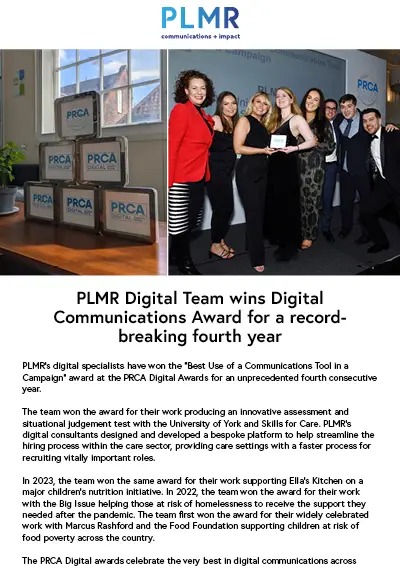The campaigning landscape is arguably evolving faster than ever before. Social media is constantly updating, shifting and becoming more sophisticated, with online organisational tools allowing us greater access to the political agenda than any previous generation.
Although the digital sphere has, in many ways, democratised campaigning, it is still very much an art form which requires attention to detail and careful planning. Here are four steps to set your campaign up for success, no matter what change you are trying to achieve, by utilising all the tools you have at your disposal, from traditional lobbying techniques to online petitioning, and beyond.
Step one: be specific
While campaigning to ‘end sexism’ would be brilliant, this ask isn’t exactly tangible and is therefore unlikely to succeed. The way to get supporters and decision makers on board is to ensure your campaign ask is as specific and achievable as possible.
For example, my campaign to end tampon tax (the five per cent luxury tax applied to all period products), which changed UK law in 2021 and is set to change EU law in 2022, partly owes its success to honing in on a very specific area of consumer policy. I wanted this particular tax to be axed because it was a symptom of sexism, plain and simple – why were tampons deemed to fall under the ‘luxury’ category, whereas maintaining private helicopters and bingo games count as ‘essential’? I could demonstrate how damaging the tax was to society, both in terms of the message it sent about the value of women and its facilitation of period poverty, and immediately I gained supporters.
I like to think of campaigners as tree surgeons, and I imagine the overarching societal problem they’re trying to tackle as if it is a tree. For example, by starting my tampon tax campaign, I was trying to tackle the big tree of sexism, with socio-political and historical roots which spread across the world. This humongous tree is far too large for me to tackle all by myself. Instead, like a good tree surgeon, I focused on just a small branch by deciding to focus on tampon tax, because the smaller the branch, the more likely I am to succeed at cutting it down. If all campaigners focused on just one small branch of this tree, it would be defeated in no time!
Step two: identify your decision maker
Once you narrow your campaign’s focus, you will need to identify who is in control of pulling the levers to make it happen. This person, entity or group will be your decision maker, which your campaign will target. Be open minded here. Your decision maker isn’t always the Prime Minister or even a parliamentarian. Rather, you may need to target a brand, school governing body or local councillor, to ensure your campaign succeeds.
To identify your decision maker, draw or think of a ladder. At one end is you, right now, with your campaign idea. At the other end is your campaign succeeding. Try to think of all the people you can contact and ask to support you along to way. While doing so, keep in mind who/what holds the power to make your change a reality.
This ladder will essentially kickstart your stakeholder map, comprising those who can help your campaign succeed. These may be political, such as parliamentarians, All-Party Parliamentary Groups (APPGs), Select Committees, special advisors, or political party headquarters. Stakeholders may also be local, including university societies, community groups, local businesses, schools, councillors, mayors, constituency political groups, and national, including unions and national charities and organisations which could help promote your agenda and messaging.
Step three: choose your platform
There are a wealth of campaigning vehicles you can choose to utilise, from online petitions to in-person protests, social media outreach to community or school clubs and societies. Some of these platforms can work together, but remember different platforms will suit different campaign aims, so think tactically about what form you want your campaign to take.
For example, I chose to focus my tampon tax campaign efforts on petitioning, because I knew success for me would be a numbers game. A few months after I launched the campaign, and before it gained much traction, my friend’s mum, Gill, told me she signed my petition because she used to campaign to end tampon tax when she was my age. Similarly, when I met with Stella Creasy MP to discuss campaign tactics, she told me she campaigned for this exact change when she was in school. I knew I would be easy to ignore as a young female campaigner, much like Gill and Stella, yet thousands of people signing a single petition would be much more difficult to cast aside. Once my petition surpassed 100,000 signatures, the Chancellor of the Exchequer started to take note.
Step four: Promote and get creative
Now you’re ready to start planning creative ways to promote your campaign and amplify your campaign’s message! Think outside of the box and be as creative as you can. You might want to organise a protest, political picnics (a food feast outside parliament at which you organise your next campaign steps) or social media supportive campaigns which can engage your audience.
These creative projects will be further amplified if you work alongside the media effectively. This will mean contacting local media in the constituency of parliamentarians you meet, pitching articles to mainstream media when you feel you can add meaningful content to a story, or when you are expecting a big campaign milestone, and engaging with both regional media and broadcast journalists.
Whether your campaign tackles a symptom of sexism, racism, classism, or something completely different, I hope the above steps help you set your campaign up for success. Thanks to online campaigning tools like petitions, more people are getting their voice heard than ever before. Today, your voice can make real change.




